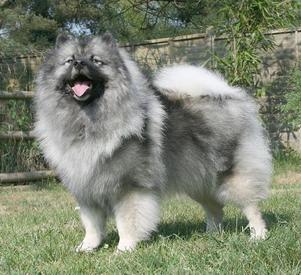
Brought into existence in 1800s Amsterdam, the Keeshond or 'Dutch Barge Dog' was primarily bred as a watchdog on barges that travelled along the River Rhine, serving as a guard and companion dog. At the beginning of the French Revolution, the Keeshond served to symbolize the Dutch Patriot political party and lost significant favour as a result. Baroness van Hardenbroek undertook careful breeding in 1920 to resurrect the breed, something which re-kindled interest in the Keeshond and increased its prevalence. The breed's ancestors are likely to be the Chow Chow, Samoyed, Norwegian Elkhound, Pomeranian and Finnish Spitz.
Typically Spitz, the Keeshond is compact and sturdy with a defined muzzle, upright, triangular ears, dark eyes and a wedge-shaped head. The coat is profuse and wiry, standing away from the body and is commonly coloured in shades of grey, black and cream. The tail plume is usually much lighter in colour, whilst curling over the back. The Keeshond is a particularly devoted breed, often referred to as its owner's 'shadow.' If you enjoy a quiet life, the Keeshond is not for you, boasting a loud, trilling bark that is characteristic to the Spitz.
Playful and agile, the Keeshond should be observed at all times, especially in public areas and in gardens with low fencing. Capable of jumping to significant heights, the modern Keeshond excels in rally, agility and competitive obedience. If you are looking for a versatile companion dog, able to display fearlessness in the face of threat, whilst remaining gentle and mannered when unprovoked, the Keeshond is a suitable breed choice for you. Obedient and eager to please, the Keeshond is well suited to domestic life, either for a family or dedicated sole owner. A fully mature Keeshond will weigh 15-30 kg depending on its gender, with a life expectancy of 12-15 years.
Besides the common health afflictions prevalent across breeds, including optical disorders, skin allergies, orthopedic problems and epilepsy, the Keeshond is susceptible to von Willebrand's Disease, a rare bleeding disorder, as well as Cushing's Disease and thyroid inefficiency.
Do you own a Keeshond? Let others know what they're like!
Related products
Advantage 80 Spot On Flea Control Large Cats and Rabbits
from £10.89
Advantage 40 Spot On Flea Control Cats, Small Dogs and Rabbits
from £10.89
Advantage 100 Spot On Flea Control Medium Dog
from £10.89
Drontal Tasty Bone Wormer Tablets for Small & Medium Dogs (2 to 20kg)
from £1.69
Advantage 250 Spot On Flea Control Large Dog
from £10.89
FRONTLINE Plus Flea & Tick Treatment Dogs & Cats
from £16.29
TermaWorm™ Tablets for Cats & Dogs
from £1.59
Drontal Tasty Bone XL Wormer Tablets for Large Dogs (Over 20kg)
from £5.09